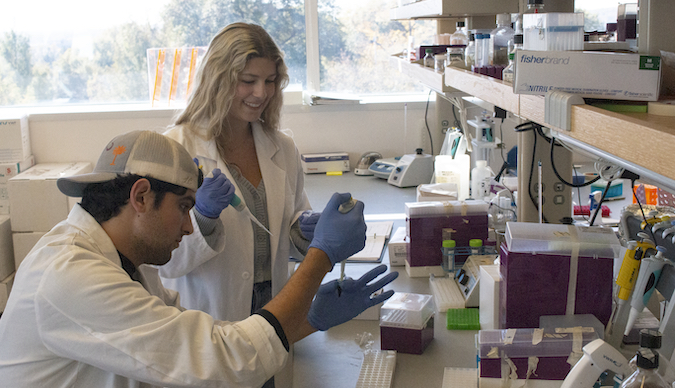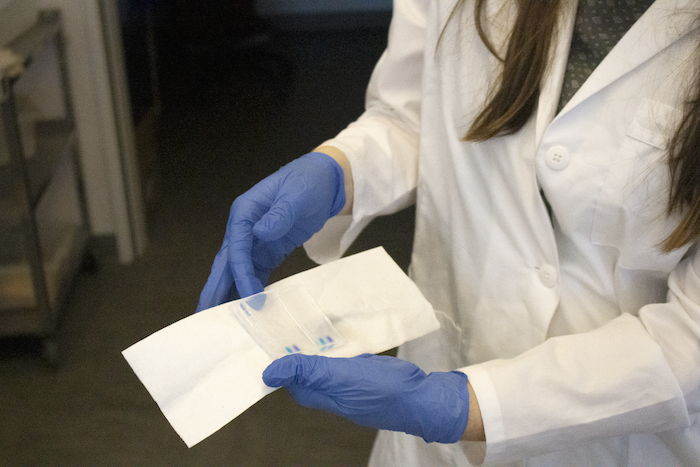Stopping the Spread
Nobody thinks they can get sick from one sip of water, but in some areas of the world, it happens all too often. Untreated water can lead to the ingestion of parasites, such as Entamoeba histolytica. Consumption of this parasite causes a disease known as amoebic dysentery, which results in cramping, severe diarrhea and in extreme cases, death. The Metabolism in the Human Parasite Entamoeba histolytica Creative Inquiry project, mentored by Dr. Cheryl Ingram-Smith in the Department of Genetics and Biochemistry, investigates how to prevent this parasite’s spread in the environment, in hopes to eventually eradicate the disease.


In the lab, the team specifically analyzes the encystation process of E. histolytica in humans and factors that encourage it. Encystation is how the parasite forms a cyst, or hard outer shell, around itself as protection. This hard shell allows the parasite to survive outside of its host’s body. Once ingested, the cyst surrounding the pathogen sheds away. Then, E. histolytica is active in the body which can cause amoebic dysentery. Once the parasite is ready to exit the body, it forms another cyst and exits through the intestines. Outside the body, the parasite travels through the sewer system and infects people who use untreated water for drinking or cooking.
The key to stopping the spread of E. histolytica is to prevent the encystation process, removing the parasite’s protection in the environment. Without the cyst, the parasite cannot survive outside of the body. “Interrupting [encystation] would be helpful not only for it not being able to exit the body if it doesn’t encyst, or if you could damage that process, then it would leave it more susceptible to environmental harms,” Jenna Matthews, a senior biochemistry major, said. More broadly, if the team can discover how to stop a cyst from forming, they may have a way to prevent the spread of amoebic dysentery since E. histolytica is the sole cause of the disease.
Although this disease is not very prominent in the United States, it is found in many developing countries that lack water purification and sewer systems. “We’re very lucky that in America, it’s not that big of a problem, but that doesn’t mean that we shouldn’t care about this kind of disease,” Annabelle Harris, a junior microbiology major, said.
Additionally, those who are infected have the added difficulty of paying for expensive medical bills. Preventing the spread of disease in the first place will save money that otherwise would have been spent on treatment.
The team conducts their research through computational analysis and work in their laboratory. The computational work involves comparing different gene sets and sequences from E. histolytica with those from other organisms. Looking at the genes’ effects in other organisms can help the team identify genes that could be important to E. histolytica’s life cycle. In the laboratory, the team does experiments with gene silencing where they turn off a gene so that it is not being expressed, allowing them to figure out the gene’s role in E. histolytica. Then, they examine whether or not encystation still takes place without that gene. This provides insights into the gene’s influence on cyst formation and potential prevention strategies.
Given the lack of treatment and purification options in developing countries, this research could one day help prevent the spread of disease causing parasites such as E. histolytica, in turn helping everyone drink water worry-free.
Infection Cycle of Entamoeba histolytica

1. Entamoeba histolytica cysts survive in the environment
2. Cysts are ingested by humans from contaminated sources (e.g., water)
3. Excystation (parasites exit the cyst) occurs in the small intestine
4. Colonization and encystation occurs in the colon and cysts shed through bowel movements
5. Possible invasion of intestinal lining occurs in the intestines before encystation
Unlock Your Potential
Find a CI Project
Click below to search for projects that are actively recruiting students from your major(s).
Current CI Projects
Click below to view current active CI projects.

